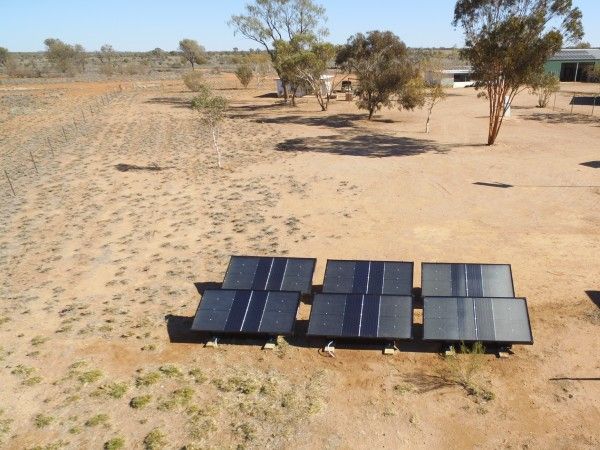Opinion: Sustainable farming communities need sustainable water
Cody Friesen founded Zero Mass Water to ensure that clean drinking water was not only accessible but also sustainable, no matter where you are in the world. Avoiding the waste and carbon footprint of current solutions such as bottled water, Zero Mass Water created a Hydropanel that makes water out of air, literally.
Its SOURCE Hydropanels extract water vapour from the air and, with the help of sunlight, create and mineralise water that can be delivered to a tap, all while remaining off-grid. The company’s Director of Market Development in Australia, Kristen Roy, presented on Global Table’s Water Solutions Across the Value Chain panel in 2019.
Now available in more than 30 countries, SOURCE Hydropanels were recently installed in Murrurundi, one of many drought-affected towns in New South Wales, where they will provide 1,500 litres of clean, renewable water per month to primary school students who were otherwise reliant on plastic water bottles.
But Murrindindi isn’t the only town in need of reliable water in Australia. Many remote communities are ill-serviced by our one-size-fits-all approach to water delivery that focuses on the large-scale needs of agriculture or our bigger cities. Here, Friesen explains why sustainable farming communities require a well-serviced community as well as sustainable farms – and how we might achieve this in Australia.
It would be trite to say that Australia needs to talk about water. We are, as a country, already engaged in a daily conversation about water and the lack of it in many parts of the country. I don’t think anyone envies the local, State or Federal government departments tasked with leading that conversation. The water problem is a big one, and all eyes are focused on a big solution. But what is the impact of large-scale solutions on smaller-scale communities? And is there room for new thinking around tailored water supply systems for remote and regional areas?
The traditional water supply systems used currently in Australia are based on designs developed by the Romans for large cities. In most cases, these systems work well, albeit with very high capital and operating costs. They also rely on a regular supply of chemicals and daily intervention by experienced and well-trained operators.
But these systems are very difficult to replicate across Australia’s hundreds of remote communities and small regional centres. These communities are instead serviced by comparatively simple water supply systems like bores and rain tanks, with only basic treatment and disinfection attached to the systems. Water from these supplies can look or taste very poorly, have potential health impacts and, in the case of rainwater tanks, sometimes not run at all.
In these regional communities, the conversation is dominated by the crippling effect that a critical shortage of agricultural-scale water has on farming incomes. But regional communities are more than just the sum of their farms. The insidious effect of low-quality or no drinking water cuts deep into the regional psyche at all levels.
It’s felt when the school bubbler runs dry and parents must buy slabs of water bottles to send with their children to school. It’s felt when the elderly can’t drive to the water station to collect emergency trucked water. When local pub owners can’t serve water at all and struggle to serve beer in glasses stained by chemical residue. When under-resourced council teams bear the responsibility of fighting for State funding and logistically handling the emergency delivery of hundreds of thousands of litres each week to centralised filling stations. The same councils face the burden of processing huge volumes of empty plastic bottles through recycling systems that aren’t designed for the scale of these loads.
The financial, practical and emotional stress of supplementing water supply permeates the community beyond the farm gate and widens the social and economic gap between regional and urban centres even further.
Our Director of Market Development Kristen Roy spoke at Global Table’s 2019 event about how we need to aim not just for sustainable farming but for sustainable farming communities. Access to drinking water is at the heart of this objective. To that end, communities need water solutions that can account for the significant differences between urban and remote contexts, including economies of scale, logistics challenges and long distances. By deploying our product SOURCE – a hydropanel that uses sunlight and air to produce clean water – we have been able to demonstrate how new water technologies can be tailored to the landscape to improve wellbeing and economic and social outcomes in farming communities. Hydropanels are 100% off-grid and use only solar energy to extract water molecules from the air, allowing residents to drink the highest-quality water in the most remote or dry locations.

Zero Mass Water SOURCE Hydropanels
The most powerful response I’ve had to a community hydropanel installation came from a Walgett local, who told us that SOURCE offered “the hope that we haven’t been forgotten; that people are out there thinking of ways to get us clean water”.
However, our assessment of public funding has found that water-related grant streams tend to focus on expanding traditional infrastructure to the exclusion of encouraging new, tailored solutions like SOURCE. We need to catalyse innovative thinking in the water sector to ensure that big solutions don’t leave small communities behind.
There’s room for more voices in the water conversation. Let’s hear them.
Cody Friesen, Founder, Zero Mass Water


